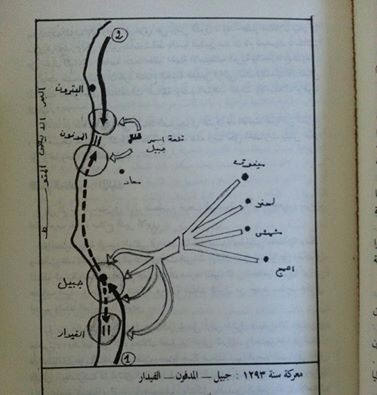|
The
battle of the "Triangle" 1293
On this Veterans' Day in America, here is a map,
published in my book "Pluralism" (al Taadudiya Fi Lubnan)
showing the army movements during the most powerful
battle in Lebanon's history and the single largest
victory of what was then a "Lebanese Resistance" against
the Mameluk invading armies. My book was published in
May 1978, after three years of research and writing, by
the Kasleek University research Center. Part I of the
book retraced the evolution of what was known as the "Marada
states" (dawlat al Marada) which lasted from circa 680
AD to circa 1305 AD, close to seven centuries. These
chapters were the first ever written material about the
strategic evolution of an "Aramaic speaking Mountain
state" which borders evolved, expanded and shrunk.
Previously Father Butros Daou had included some of this
information based on Ibn al Qala3i medieval chronicles.
Unfortunately Lebanon's educational system had erased
any reference to the "Marada states" since 1943, and
thus students never learned about these important events
at school.
The battle of the "Triangle" or "al Muthalath" was
fought in 1293 AD, as one battle of the Mameluk war on
Mount Lebanon which lasted close to a century. The
battle involved three locations, Byblos in the center,
Fidar in the south and Madfun in the north. The Mameluks
were attempting to end the independence of the Marada
state in Mount Lebanon by seizing the entire coast
between Beirut and Tripoli and capturing the only port
city which linked Mount Lebanon to the rest of the
world, including Byzantium and Europe. According to
several accounts, a Mameluk army of 100,000 (unsure
about these numbers) advanced from Beirut towards
Byblos-Jbeil, while another army of 60,000 marched from
Tripoli towards Byblos. The Moqaddamins (civilian-military
commanders) of the Maradas met in Maad (Jbeil district)
and decided on a battle plan. Since their numbers were
close to 30,000 (some say 40,000) they were at a
disadvantage. They placed a force around Fidar, another
around Madfun and positioned the rest on the hills above
Byblos. They've asked the population of Jbeil to sail
away with all the ships and act as if the inhabitants
had left in a rush, leaving behind them most belongings
and their homes with all the possessions.
The Fidar ambush allowed the first Mameluk army to cross
unharmed reaching Jbeil by afternoon. The conquerors
found the city empty of its inhabitants and rushed to
perform "Ghazu" (spoils) and reap the benefits of the
victory. By nightfall, the core of the Mameluk army was
at rest and the battle formations have almost dismantled.
The Marada forces descended from the hills and wreck
havoc within the conquerors camp, reaching the Mameluk
commanding group and eliminating them. The Mameluks fled
by the thousands towards the south, were the Fidar
ambush destroyed most of them and towards the north
where the Madfun ambush terminated them. The name "Madfun"
came from the notion of how many soldiers were buried in
that battle. Accounts about these three battles in Fidar,
Jbeil and Madfun are extraordinary. The second Mameluk
army coming from Tripoli arrived the next day only to
find all Marada forces of 30,000 (unsure about these
numbers) re-gathered in a defensive position and
blocking their way at Madfun. News of the crushing
defeat arrived to the commanders of the Northern Mameluk
army which decided, after few skirmishes- to pull back
and return to Tripoli.
The battle of the Triangle gave the Maradas, couple
decades more before they were defeated in 1305 AD. "Jbeil-Fidar-Madfun'
was fought by an army of 30,000 against combined armies
of 160,000. It was without a doubt the most stunning
victory of the people of Mount Lebanon in its history.
When I published "Al Taadudiya" (at the young age of 23)
I was a law student at St Joseph University. I had hoped
that more historians would dig deeper and excavate the
enormous archives of the Marada states. Regrettably most
capable historians and writers of that era were
interested in who would be the next President of Lebanon.
Little was done. In the hope that younger historians
would do what their predecessors have failed to do, I
will be summarizing some of the sections in English,
when time allows.

|